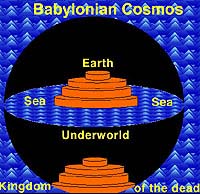 |
 Most religions have in common the characteristic of helping to define the place of human society in the larger universe. Like the diagram, right, of the "Babylonian Cosmos," religious belief systems provide a mental map of how we fit together with everything around us. Many religions have as their central or fundamental story a myth of origins. Often these origin stories tell of the creation of the entire world, but sometimes they focus instead on the Ancestor who founded the community. Many origin myths, as well as other aspects of religious dogma, contain rationales or justifications of how and why and by whom the community is led or ruled; rulers, for their part, actively pursue favorable identifications within the religious belief systems of their culture (see discussion of the state in the Social Organization section of these pages).
Most religions have in common the characteristic of helping to define the place of human society in the larger universe. Like the diagram, right, of the "Babylonian Cosmos," religious belief systems provide a mental map of how we fit together with everything around us. Many religions have as their central or fundamental story a myth of origins. Often these origin stories tell of the creation of the entire world, but sometimes they focus instead on the Ancestor who founded the community. Many origin myths, as well as other aspects of religious dogma, contain rationales or justifications of how and why and by whom the community is led or ruled; rulers, for their part, actively pursue favorable identifications within the religious belief systems of their culture (see discussion of the state in the Social Organization section of these pages).Religious myths pack an enormous amount of cultural information for and about the community. Typically, they explain the common human lot -- the fate which all of us share -- and at the same time suggest the values which the community holds dear. The values which are most prized within a system of religious beliefs are often most prized by that religion's cultural system as well; these values in turn affect the culture's systems of social organization, their learned behaviors, and their relationship to the physical environment.
 |
There are two logical extensions of these core beliefs. First, Mayan culture would take conflict as a normative position, and a state of conflict among human society would be see as a natural extension of cosmic conflict. Second, blood (particularly the blood of the most powerful members of society, such as the ruler) would represent the most precious form of sacrifice or offering -- and the essential violence of the sacrifice would not seem out of keeping with the values held forth in the religious mythology. Following this line of reasoning from the abstract mythology to the areas of physical organization and learned behavior, we are not surprised to find that:
 Return to Values and Beliefs Gallery
Return to Values and Beliefs Gallery